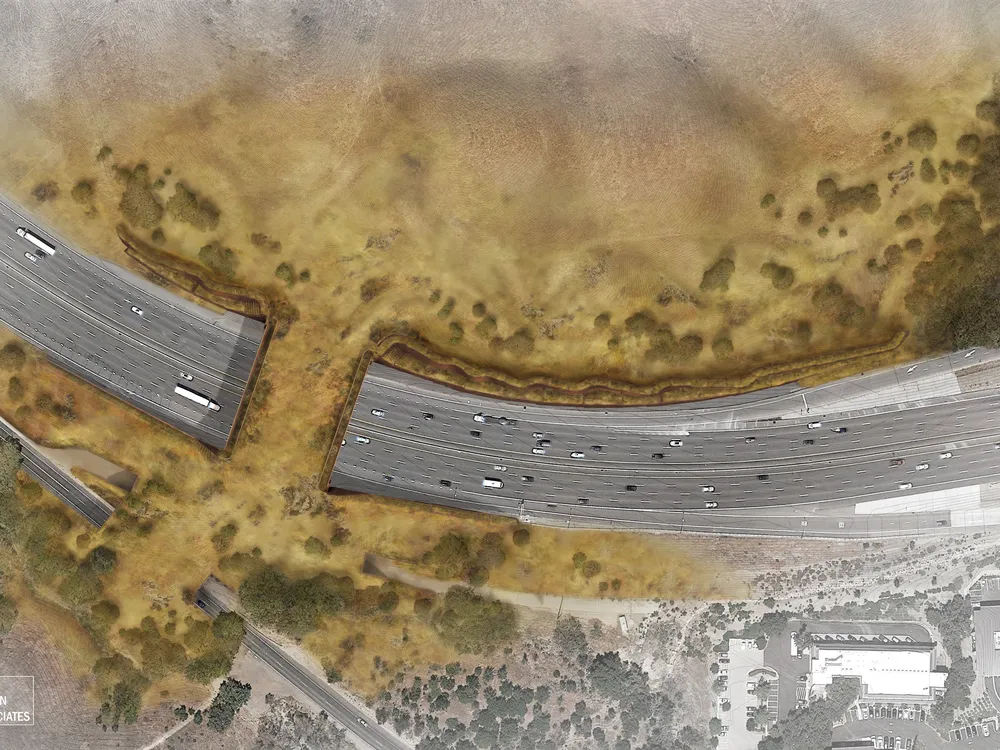
This rendering shows what the wildlife crossing will look like when completed.
Rock Design Associates / National Wildlife Federation
When freeways are built through their natural habitats, animals often end up suffering—and so do humans on the road. Every year, more than one million wildlife-vehicle collisions occur across America, resulting in 200 deaths and 26,000 injuries to drivers and passengers.
Now, an ambitious project in California aims to help address this problem. Crews are building the “largest wildlife crossing in the world of its kind” over Highway 101 in Los Angeles County.
When the project is finished in 2025, the manmade crossing should provide safe passage for mountain lions, bobcats, deer, lizards, coyotes, snakes and ants as they move between the Santa Monica Mountains and the Simi Hills of the Santa Susana mountain range.
Called the Wallis Annenberg Wildlife Crossing, the project will cost $92 million. It’s being funded via a public-private partnership between numerous collaborators, including Caltrans, the National Park Service and the National Wildlife Federation.
Crews broke ground on Earth Day two years ago. Last week, the project hit a major milestone as the first horizontal section was lowered into place above the freeway. In the coming months, crews will install more than 80 of these concrete girders, each weighing between 126 and 140 tons.
*101 Wildlife Overcrossing – Agoura Hills*
All lanes of southbound US-101 are closed from Cheseboro Road to Liberty Canyon Road from 11 p.m.-4 a.m. Monday-Friday for several weeks to set girders. Video: Erecting the crane & setting the first girder this week. #101WildlifeCrossing pic.twitter.com/RE7nmUtGKx— Caltrans District 7 (@CaltransDist7) April 19, 2024
The 210-foot-long crossing will form a bridge over eight lanes of traffic. It will eventually be covered in vegetation, including more than a million native plants, to make it more appealing to wildlife. Landscapers will also plant trees and vegetation on 12 acres on either side of the crossing to make it feel “more like walking over a hill than crossing a bridge,” as Jeanette Marantos wrote for the Los Angeles Times last year.
Though the bridge is expected to benefit many animals, wildlife experts are especially hopeful it will improve the lives of mountain lions. In the wild, they typically roam territories that span more than 100 square miles. But because of the freeways in and around Los Angeles, they’ve struggled to move around freely. As a result, some of the region’s mountain lions are now inbreeding, which makes them more susceptible to numerous health issues.
The 210-foot-long animal bridge will span eight lanes of traffic. National Wildlife Federation / Living Habitats
“The genetic diversity of the Santa Monica Mountains population is among the lowest ever documented for the species,” according to the National Park Service.
Per the project website, the big cats could “vanish from the area within our lifetime” if genetic diversity doesn’t improve.
In recent years, the story of one particular mountain lion, known as P-22, was widely publicized. Born around 2010, P-22 had crossed at least two busy freeways to take up residency in Los Angeles’ Griffith Park. He spent more than a decade roaming his small territory, isolated and without hope of finding a mate. He was a “lonely, dateless bachelor, roaming the Hollywood Hills, and cut off from the rest of his kind,” according to the project’s website.
The bridge will be covered with native plants to help encourage animals to use it. Rock Design Associates / National Wildlife Federation
In December, wildlife officials euthanized P-22 after he attacked two pet dogs. His necropsy later showed that he’d suffered injuries consistent with being hit by a car—a skull fracture—as well as kidney disease, arthritis and other chronic health conditions.
P-22’s legacy will live on in the form of the new wildlife crossing, which aims to help save other mountain lions from suffering the same fate. His story inspired thousands of people and organizations to make donations to the Wallis Annenberg Wildlife Crossing.
“He wasn’t just a celebrity influencer,” Beth Pratt, the California regional executive director for the National Wildlife Federation, told NPR’s “Morning Edition” in 2022. “He was someone who used his celebrity for good … and put a real story to the impact of these highways.”
